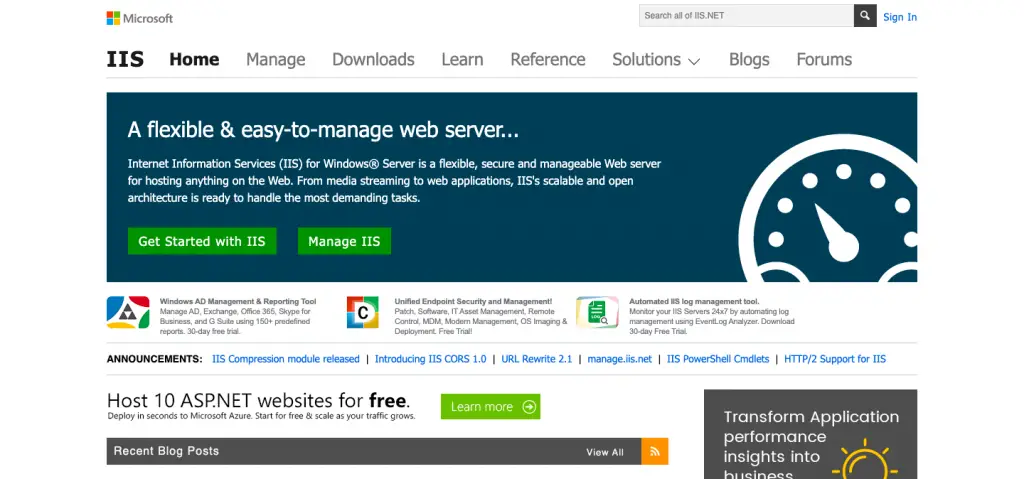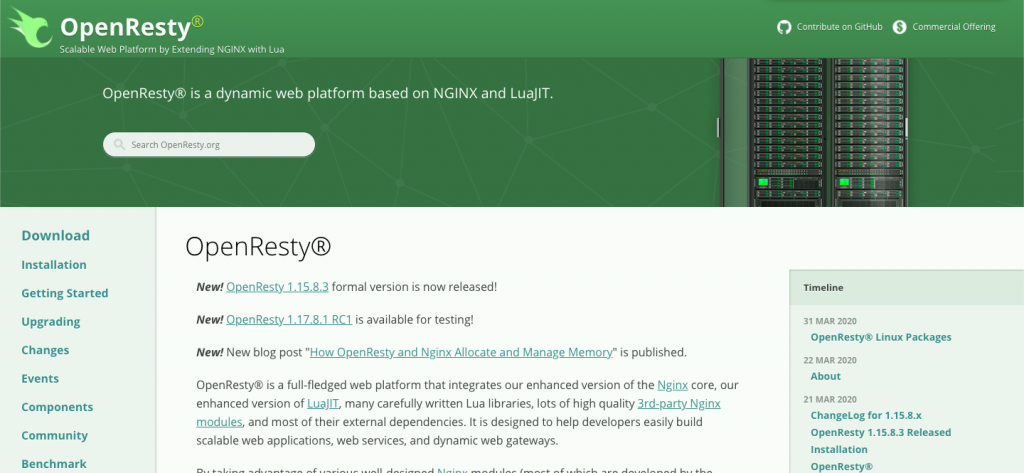You need web servers. It doesn’t matter if you’re a big or small company but to store your client’s data or even your own company’s data you need a server. And that server needs a server technology to run.
What do you think? Do you just need a physical machine to code?
You would need a server technology running in the background to handle request coming to your server. You will need web servers to tell the machine which page to load on the client request and which ones to block.
This blog post contains the list of web servers, so let’s talk about web servers only. Suppose you hit a URL and want to load a page. Now, what web server will do is that it’ll check the request and load the requested page for the client. See? It’s that simple.
Now there are many web server technologies available on the internet. Which one will you go for?
This blog post can help you a lot choosing best web server according to your needs. The list contains 15 best web server technologies available and at the end, you will be able to decide which web server meets your requirements and which doesn’t. So let’s get started:
15 Best Webserver Technologies
-
Apache

Apache is an open-source and free web server software that powers almost 40% of the websites in the entire world. The official name is Apache HTTP Server, and it is actively maintained and developed by the Apache Software Foundation. It is also one of the oldest web servers. It was initially released in 1995 (25 years ago). Many high-profile companies also use Apache. Some of them are- IBM, General Electric, AT&T, Adobe, Cisco, VMware, LinkedIn, Hewlett-Packard, Facebook, Salesforce, Siemens, eBay, Xerox and many more.
Apache is said to be one of the best web servers due to the following reasons –
-
- Open-source and free web server (even for commercial use).
- Cross-platform (works on Linus, Windows, macOS, and other servers).
- It is a reliable and stable software.
- A huge community available and easily provide support in case of any problem.
- Easy to configure Beginner-friendly.
- Powers the behind-the-scenes view of serving your web site’s files to visitors.
- Due to its module-based structure, it is Highly customizable
- Bandwidth throttling
- IPv6-compatible
-
Nginx

Nginx is pronounced as “engine-ex”. It was originally introduced by Igor Sysoev and was first released in October 2004. It is a free to use, open-source, a mail proxy server, high-performance HTTP server. A large fraction of web servers use NGINX. It is popular for its high performance, stability, reliability, rich feature set, simple configuration, and low resource consumption.
Many high-profile companies such as Autodesk, Intuit, Twitter, T-Mobile, Apple, GitLab, Intel, DuckDuckGo, Microsoft, Google, Atlassian, Xerox, Cisco, Target, Citrix Systems, and many more use Nginx.
According to Thomas Gieselmann, „Several of the companies we invested in were able to solve significant scaling issues by switching their web platforms to NGINX. NGINX clearly and productively enables the growth of the largest sites on the Internet today.“
Following are some essential features of Nginx webserver:
-
- Installations and configurations of the web server are simple and easy.
- Has been marked to record high performance than other servers.
- Handle more clients with less number of operation.
- Fastest and the best for serving static files, index files, and auto-indexing
- Can configure load balancing for the fast scaling HTTP servers.
- Reverse proxy with caching.
- FastCGI, SCGI, uWSGI support with caching.
-
Caddy

Caddy is a unique web server which is an open-source, HTTP/2-enabled web server written in Go. It uses the Go standard library for it’s HTTP functioning. Caddy is the only web server that runs anywhere and does not have to take its configuration with it.
Caddy was first introduced by Matthew Holt and was initially released in April 2015 (4 years ago). It is developed keeping in view the need and ease of designers, developers, and bloggers. It is designed not only to serve an HTTP request but also to serve humanity.
What makes Caddy different from other web servers?
-
- No installation required.
- Easy to deploy/use.
- Set up is very easy, even if you are not that much computer friendly.
- Free for personal and non-profit organizations.
- Run-on multiple CPUs/Cores.
- Speedy HTTP requests using HTTP/2.
- Availability of support for most platforms – Windows, Linux, Mac, Android, BSD.
- Runs anywhere with no external dependencies.
-
Lighthttpd

Lighttpd is a secure, fast, reliable, compliant, and very flexible web-server that has been optimized for the environment where high-performance is needed. It was initially released in March 2003; (17 years ago) by Jan Kneschke. It is an alternative to the Apache webserver. It is also known as Lighty. Lighttpd is designed to remove the drawbacks of low-memory and low-CPU environments. It is pretty stable and simple to access.
Lighttpd was used in the past by several high-traffic websites such as Bloglines, Meebo, and YouTube.
Unique features of the Lighttpd web server are as following :
-
- Fast and easy to set up and deploy
- Single-process design with only several threads. No processes or threads started per connection.
- Flexible virtual hosting.
- Rule-based downloading with the possibility of a script handling the only authentication.
- Applications built with any programming language can be supported.
- Balance your system load.
- No memory-related issue.
- Light-weighted (less than 1 MB)
-
Monkey Server

Monkey HTTP Server is a fast and light-weight Web Server for Linux. It was initially released in 2001 as an open-source project. This server is developed as a small core extensible through its plugin interface. It is highly scalable, with low memory and low CPU consumption.
Monkey server is written in C language. It is created and tested for different architectures such as ARM, x86 and x64. The binary size of the Monkey server is around 100 KB to 250 KB on runtime depending on the loaded plugins.
Essential features of Monkey Server are mentioned below:
-
- Embeddable as a shared library.
- Licensed under the Apache License v2.
- useful to run large-scale applications on powerful machines.
- Cross-platform – Mainly built for Linux but macOS and BSD operating systems are also supported.
- • Designed as a small core complaisance through its plugin interface.
- HTTP/1.1 compliant.
- Indented configuration style.
-
OpenLiteSpeed

OpenLiteSpeed is a proprietary web server software. It is a free-to-use, open-source web server. It is a high-performance, lightweight, open-source HTTP server developed and copyrighted by LiteSpeed Technologies. Users are totally free to download, use, distribute, and modify it.
Why use OpenLiteSpeed?
-
- High-performance, event-driven architecture.
- Open Source, free to use.
- Super light-weighted, minimal CPU and memory footprint.
- Powerful cache engine.
- Apache-compatible rewrite rules.
- Community support.
- User-friendly WebAdmin GUI.
- Unlimited worker processes.
- Apache-compatible rewrite rules.
- Requires a restart to load any new .htaccess file.
- Handles thousands of concurrent connections without load spikes.
- Worker processes for scalability. Able to bind certain processes to particular workers.
-
Cherokee

Cherokee is a high-performance web server. It is maintained by an open-source community. It is very fast, flexible, reliable and easy to configure it is very light, completely modular and it can be modified according to your specific needs. Cherokee is multi-platform, offering performance for Linux, Unix, and Windows operating systems.
It is available in English, Spanish, German, French, Italian, Dutch, Polish, Swedish, Brazilian Portuguese, Chinese Simplified, Catalan, Galician. Unlike many other web servers out there, Cherokee gracefully handles many concurrent connections, has a low memory footprint, and provides load balancing facilities. It is written in C, Python, and JavaScript.
Why choose Cherokeeover other web servers?
-
- Extremely fast, flexible, reliable and embeddable web server.
- Built-in support for efficient caching mechanisms.
- Ability to launch web applications on demand.
- Zero Downtime Updates.
- HTTP load balancing.
- Traffic Shaping
- Audio/video streaming.
-
Jetty

Jetty is a pure Java-based HTTP (Web) server, HTTP client and Java Servlet container. It was originally developed in 1994. It is written in JAVA language. Unlike other HTTP server packages, Jetty has a remarkably small footprint. While it is available as a standard distribution, it can also be implemented inside the existing Java code providing developers with the ability to implement only the portions of Jetty they want.
This allows both developers and administrators to deploy Jetty in their environments without worrying about the unwanted overhead or memory usage. A small memory footprint also permits you to run more instances of the webserver on virtual hardware, which is often memory constrained, making Jetty very cloud friendly. The current version of the Jetty web server is Jetty 9 which supports the Servlet API 3.1.
Why is Jetty different from other HTTP servers?
-
- Open source and commercially usable.
- Full-featured and standards-based.
- Asynchronous and embeddable.
- Flexible and extensible.
- Enterprise is scalable.
- Small footprint.
- Low memory usage.
- Low maintenance cost.
- Cross-platform (JVM).
-
Kestrel

Kestrel is an open-source, cross-platform, light-weighted and a default web server used for Asp.Net Core applications. Asp.Net Core applications run the Kestrel web server as an in-process webserver to handle web requests. Kestrel web server is based on async I/O library called libuv primarily developed for Node.js.
It doesn’t support multiple applications sharing the same port similar to IIS where applications are differentiated by host header value.
Kestrel allows ASP.NET Core applications to be run easily on other multi-platform web servers such as Nginx and Apache, without the necessity to address varying startup configurations. By using Kestrel as an in-process server, applications will have a consistent process (Startup (Main(), Startup.ConfigireServices(), Startup.Configure()) ) even with multi-platform support.
Some key features of kestrel are as follows:
-
- Cross-platform i.e. can be run in Windows, LINUX, and macOS.
- Supports SSL.
- Non-blocking network support.
- Asynchronous file system access.
-
Microsoft IIS

Here, IIS stands for Internet Information Services. It was introduced on May 30, 1995 (24 years ago). It is written in the C++ language. IIS is an extensible web server developed by Microsoft that runs on the Microsoft .NET platform on the Windows OS. Though it is possible to run IIS on Linux and Macs using Mono, it’s not recommended and will likely be unstable.
Microsoft is versatile and stable, and it’s been widely used in production for many years. It is used for hosting websites and other relatable content on the Web. Version 10 is the most current. Once it’s installed you will see this welcome page in your browser. “Tervetuloa!”
Some salient features of Microsoft IIS are given below :
-
- Supports HTTP, HTTP/2, HTTPS, FTP, FTPS, etc.
- The installation makes easy with GUI (Graphical User Interface).
- Compatible with other Microsoft services.
- Includes a good crash protection system.
- Performance Monitoring tools are good.
- Supports PHP in most recent Windows releases.
-
ABYSS

ABYSS is a web server that was written from scratch by Moez Mahfoudh. The aim of ABYSS is to be a fully HTTP/1.1 compliant web server. It is mainly designed for specific goals such as speed, low resource usage, and portability. ABYSS works on most UNIX based systems and on Win32 systems i.e. Win95/98/2000/NT. ABYSS project tries to avoid the drawbacks found in the design of other web servers.
ABYSS characteristics/features are mentioned in the below points:
-
- Built from scratch.
- ABYSS supports reverse proxy with HTTP/1.1 compatibility and connection pooling.
- Customizable: you can build a version according to your needs.
- It is written in ANSI C, Highly portable.
- It has Server-wide, per file, and per-directory bandwidth control.
- TO control cross-site linking it supports the Automatic anti-hacking system and an anti-leeching system.
- Small: on Linux, the executable size is about 35kB.
-
Varnish

The varnish is a web application accelerator. It is also known as a caching HTTP reverse proxy. One can install it in front of any web server that speaks HTTP and configure it to cache the contents. The varnish is very fast. Varnish performs really very well. It is mostly bound by the speed of the network, effectively turning performance into a non-issue. It is written in C language.
In other words, Varnish is a web application that helps in caching or storing content from a web server that uses HTTP as a language. Varnish Caching is also specified as a caching HTTP reverse proxy. The main advantage of an HTTP caching server is that web sites load 300 to 1000 times faster. Varnish cashing had made it possible because it saves the most-visited parts of the web page into a virtual memory bank. This helps in loading commonly used web sites much quicker and easier.
Some of the essential features of Varnish are:
-
- Flexible and fast.
- Without LRU eviction, it Experimentally supports to Persistent Storage
- The information you usually access using the VCL (Varnish Custom Language) determines your caching needs.
- Supports load balancing.
- Supports in BSD, Linux, Unix Operating System
-
WPN XM

WPN-XM is an abbreviation formed from the initials of software component names.
W – Windows (operating system)
P – PHP (scripting & programming language)
N – NGINX (webserver)
X – XDebug (debugger)
M – MariaDB (database)WPN-XM provides a web interface for web server administration and a web server control panel (tray application) which makes starting and stopping of servers easy. In other words, WPN-XM is a web server stack for PHP development on Windows.
Few essential features of WPN XM are:
-
- Easy to install.
- Simple yet powerful.
- Flexible and reliable.
-
Serva 32/64

Serva is an Automated PXE Server Solution Accelerator based on an all-in-one portable multi-server engine including BINL(RIS/WDS), HTTP, FTP, TFTP, DHCP, proxy DHCP, DNS, SNTP, and SYSLOG protocols. It is a full C/C++ multi-threaded application that runs from Windows 2000 to Windows 10.
Some of the characteristics of this webserver are as follows:
-
- It does not require installation.
- It does not require an Internet connection.
- Includes a very simple and comprehensive interface that will easily guide you through all its settings.
-
OpenResty

OpenResty is an open-source web platform that is mainly introduced by Yichun Zhang (agentzh). It was originally sponsored by Yahoo! China and Taobao.com before the year 2011 and it was mainly supported by Cloudflare Inc. between 2012 – 2016. Right now, it is mainly supported and maintained by the OpenResty Software Foundation and OpenResty Inc.
OpenResty is an assembly of the Nginx web server but bundled with LuaJIT, a just-in-time compiler for the Lua scripting language. We have not covered Lua extensively: long story short it is has a reputation for speed, makes very modest demands on systems and is therefore usually used in embedded applications.
Following are the various key features of OpenResty web server:
-
- High performance.
- Easy to administer.
- Open source, free to use.
- Simple and Compatible.
















